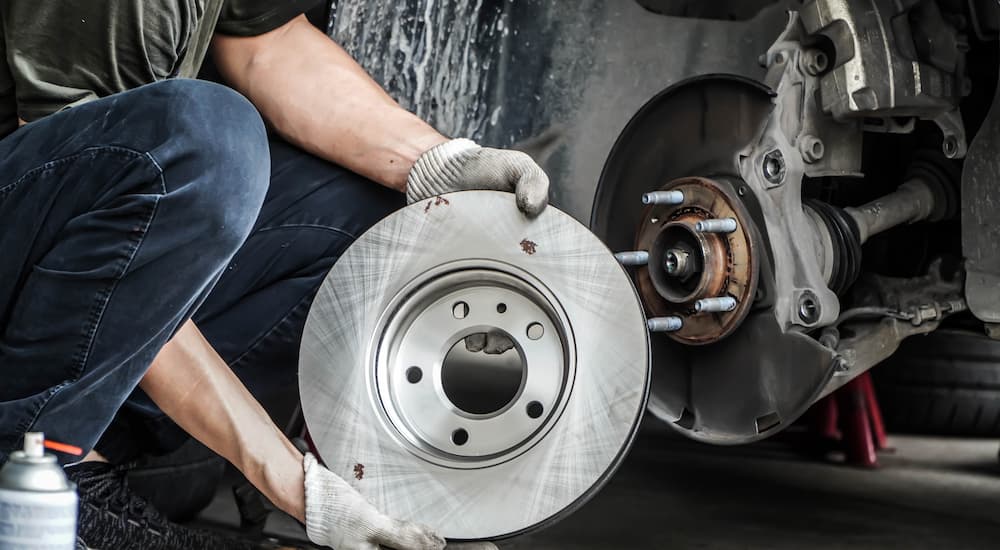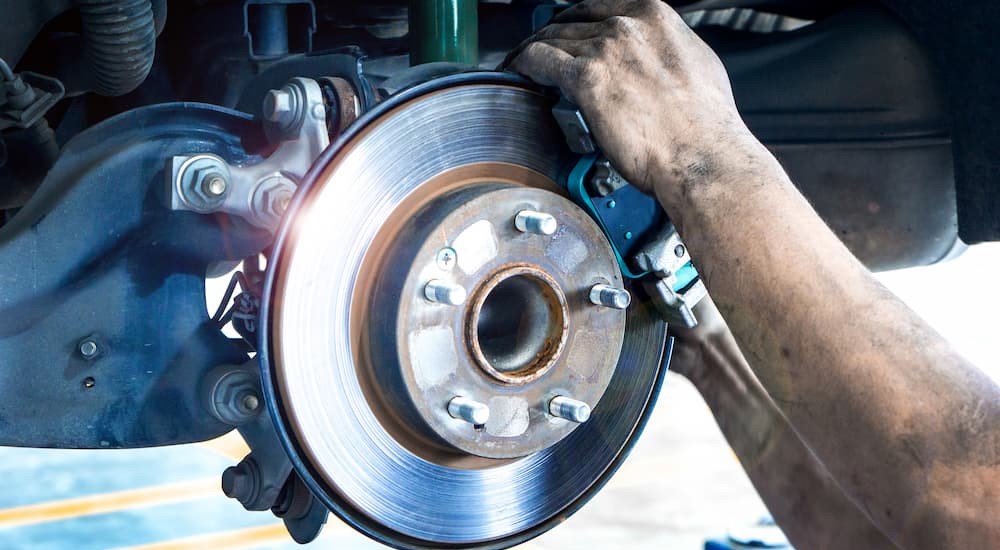You may not give your brakes much thought, but they are essential to your safety behind the wheel and your vehicle’s performance. For example, you engage the brake pedal in rush-hour traffic, maintaining a safe distance from the truck slowing down ahead of you. Likewise, you use the brakes to slow your speed on the highway to let someone merge, or quickly engage the brakes to avoid a collision or stop at a sudden red light. You do all this without a second thought, because engaging the brakes is a natural part of everyday driving.
Even so, brake service shouldn’t be ignored, nor should you let just anyone inspect, repair, or replace your brake system. When your brakes are serviced, you put your safety in someone else’s hands. Not only is it essential to know who you’re trusting, but it’s also critical to understand how your brakes operate and any signs of trouble.

How Your Hydraulic Brakes Work
Your foot engages the brake pedal, but bringing your vehicle to a safe stop takes superhuman strength. The superhuman force behind your vehicle’s stopping power isn’t your Hulk-like strength, but the brake system, which begins with the brake pedal and brake booster. Once the pedal is engaged, the brake booster multiplies the force of your foot and sends a signal to the master cylinder. The master cylinder, which houses the brake fluid, pressurizes the fluid and sends it through the brake lines and hoses to the wheels. Then, the pressure squeezes pads or shoes against the brake rotor or drum, depending on the type of brake system, as we’ll get into. This engagement creates the necessary friction to slow the spinning wheel and safely stop your vehicle.
Understanding the Different Types of Brakes
Most brakes work generally the same, but their components vary. For example, disc brakes are the most common, replacing drum brakes on nearly every modern vehicle because they’re more effective and less prone to corrosion. The growing popularity of electric vehicles also introduces us to regenerative braking, which adds another twist to modern braking systems.
Drum Brakes
Drum brakes were an industry-wide standard for decades, eventually evolving from a mechanical to a hydraulic system. As a hydraulic system, they rely on wheel cylinders, a brake drum, brake shoes, and pressurized brake fluid. Once you engage the brake pedal, the pressurized fluid travels through the brake lines and hoses to the wheel cylinders. This pressure forces the brake shoes to press outward against the inside of the brake drum, which rotates with the wheel. The curved brake shoes have a unique lining that generates enough friction to slow the drum and stop the vehicle.
The idea behind drum brakes is straightforward, but a few other components are integral to the system’s operation and effectiveness. For example, self-actuating drum brakes rely on springs to keep the brake shoes in place. The springs also increase the force with which the brake shoes press into the drum, increasing stopping power. Once you release the brake, the springs ensure the brake shoes retract to the appropriate position away from the drum.
In addition to the springs, drum brakes rely on a brake adjuster, which is usually automatic. The brake shoes are always positioned close to the drum, which ensures their effectiveness and heightens their responsiveness. Think of this proximity like the siblings getting as close as they can to one another without touching the other with their fingers, the brake rendition of the “I’m not touching you” child’s game. However, with drum brakes, the brake adjuster keeps the optimal distance between the components, keeping them close but not touching when the brakes are not engaged. This is critical as the parts wear because it ensures the drum brakes maintain responsiveness over time.

Disc Brakes
Disc brakes are the most popular type of hydraulic brakes used today. Like drum brakes, the system relies on pressurized brake fluid. However, instead of the fluid reaching the wheel cylinder, it flows to a caliper at each wheel. Disc brakes don’t rely on springs, but are self-centering and self-adjusting, allowing the caliper to move freely from side to side. Once the brakes are engaged, one or more pistons inside the caliper press toward the center. The caliper also houses the brake pads, which the pistons force against the rotor attached to each wheel. As the brake pads squeeze against the rotors, they generate enough friction to slow the wheels and stop your car.
There are a few distinctions to note about disc brakes. The lack of springs makes them far simpler by design. Moreover, it also means the brake pads maintain constant contact with the rotors. This contact is very light and can be affected by several factors. For example, any distance between the pads and rotors may result from a wobble in the rotor or the seal on the piston. Even then, the distance is minimal, with the proximity heightening responsiveness and effectiveness as soon as you engage the brakes.
Advantages and Disadvantages
Drum brakes are more complex than disc brakes, but they’re more affordable to manufacture. This means they’re harder to service, but more cost-effective to replace. However, upkeep for drum brakes borders on the excessive, because they’re prone to brake dust buildup and often have issues with the brake adjuster not working. Alternatively, disc brakes are easier to maintain, dissipate heat more effectively, and are far more responsive. In modern cars, you’ll always find disc brakes on the front, where most of your braking force comes from. Some cars still use drum brakes on the back as a cost-saving measure, but more and more models these days include disc brakes for all four wheels.
A New Type of Braking Technology: Regenerative Brakes
The growing popularity of hybrid and electric vehicles introduces a new type of brake technology known as regenerative braking. Hybrid and electric vehicles still rely on hydraulic disc brakes, with regenerative brakes considered a bonus or add-on to heighten your experience behind the wheel. How so?
Hydraulic disc brakes are effective and responsive, but the process wastes energy. Regenerative brakes solve this concern by capturing the wasted kinetic energy when you engage the brakes and transforming it into battery power. Under normal driving conditions, the battery sends power to one or more electric motors, which convert that energy into wheel rotation. Regenerative braking is the same process in reverse, where the electric motor becomes a generator that turns wheel rotation into electrical power, recharging your battery. In doing so, regenerative braking actively extends your driving range, capturing energy whenever you let your foot off the accelerator or engage the brake pedal. The process of turning wheel rotation into electrical energy can slow down the car rather quickly, without using the standard hydraulic brakes. However, this should always be considered a secondary braking system. If you need to slow down in a hurry, just press the brake pedal as you would in any car.

Warning Signs That Your Brakes Need Servicing
Disc brakes are designed to last, but still require routine maintenance and inspection. Failing to proactively maintain your brakes can lead to trouble down the road, limiting your stopping power and putting you at greater risk for an accident. Here are a few common signs beyond the standard dashboard indicator that brake service should be at the top of your to-do list.
Strange Noises When Braking
When you engage the brakes, you may hear grinding, squealing, or squeaking, none of which is normal. These noises indicate an issue with the brake pads or rotors. For example, some brake pads have wear indicators that, when worn, make a high-pitched noise as they make contact with the rotors. This is normal, but it’s an auditory indicator that means it’s time to have your brakes serviced.
A Squishy Brake Pedal
The brake pedal shouldn’t be difficult or incredibly easy to engage; it should offer some resistance. However, when you have issues with the master cylinder, like air in the system, your brake pedal loses that resistance and can feel soft or spongy. You may also notice that the same force you typically use suddenly pushes the brake pedal to the floorboard, with little or no resistance at all.
Vibrations When Braking
Your vehicle shouldn’t vibrate when you engage the brakes, nor should you feel any vibrations in the steering wheel. If this happens, it’s an indication that your rotors need attention because of uneven wear. Rotors wear down over time as the material of the brake pads transfers to the surface of the rotors. Sometimes, this transfer is inconsistent, leading to uneven wear on the rotors that presents as vibrations in the steering wheel and the vehicle itself.
Be Proactive With Your Stopping Power
Your vehicle likely relies on disc brakes to stop, which gives you an advantage because disc brakes are the most effective and easiest to maintain. However, that does not mean they can be ignored. Proactively maintaining your brakes includes knowing how they operate and the signs of brake trouble. From there, thoroughly vet the service center to ensure your vehicle and stopping power are in capable hands dedicated to instilling confidence and peace of mind behind the wheel.

